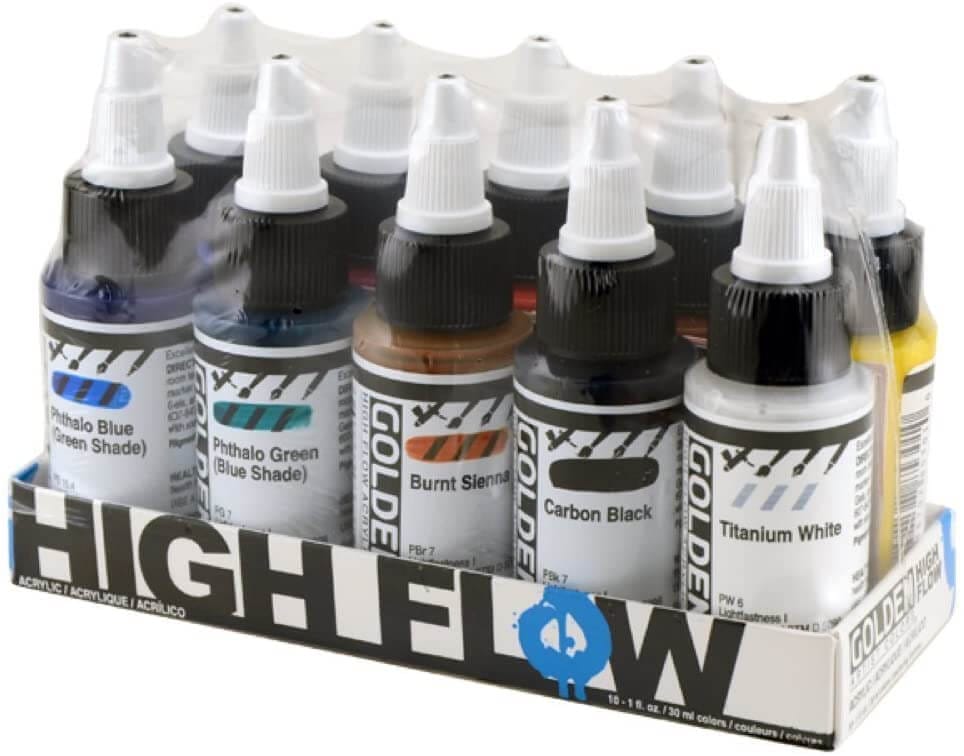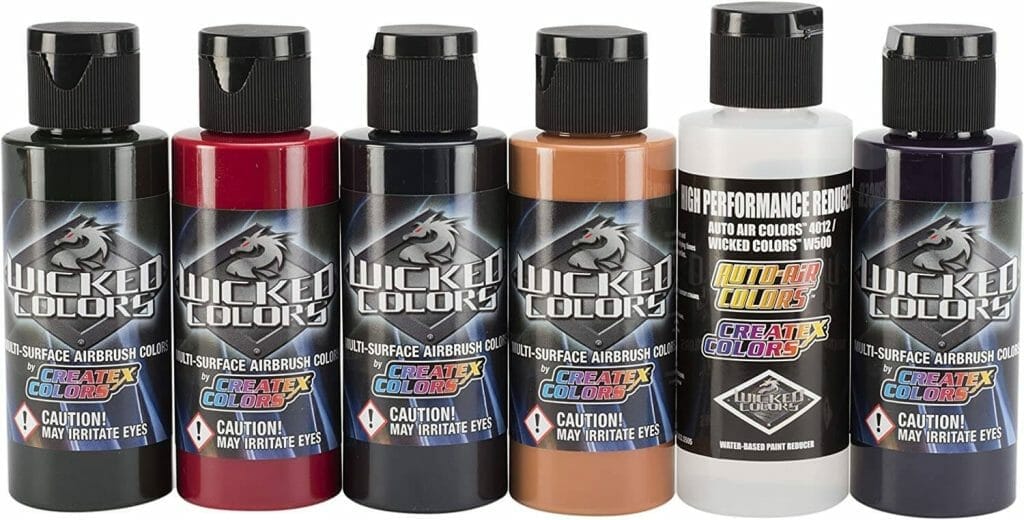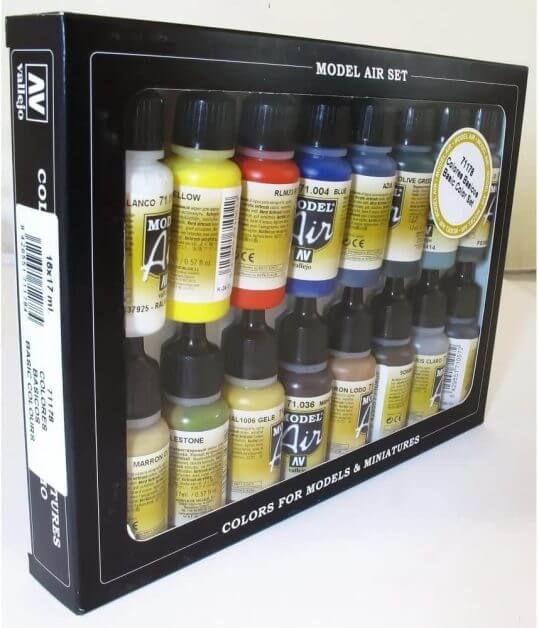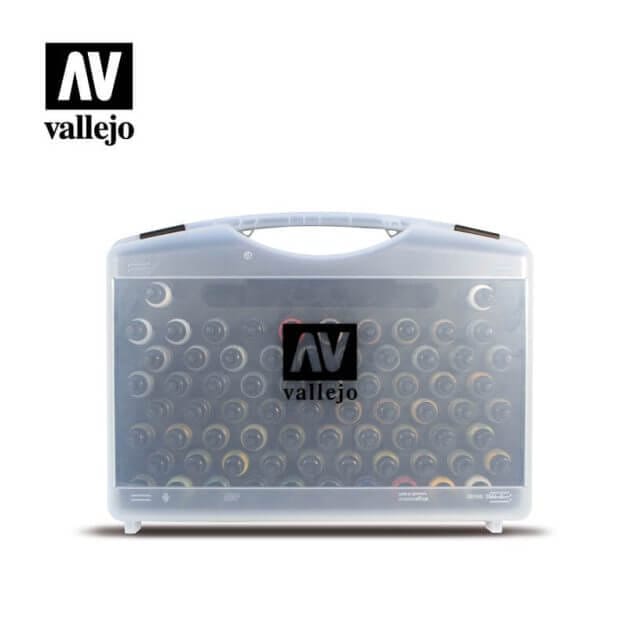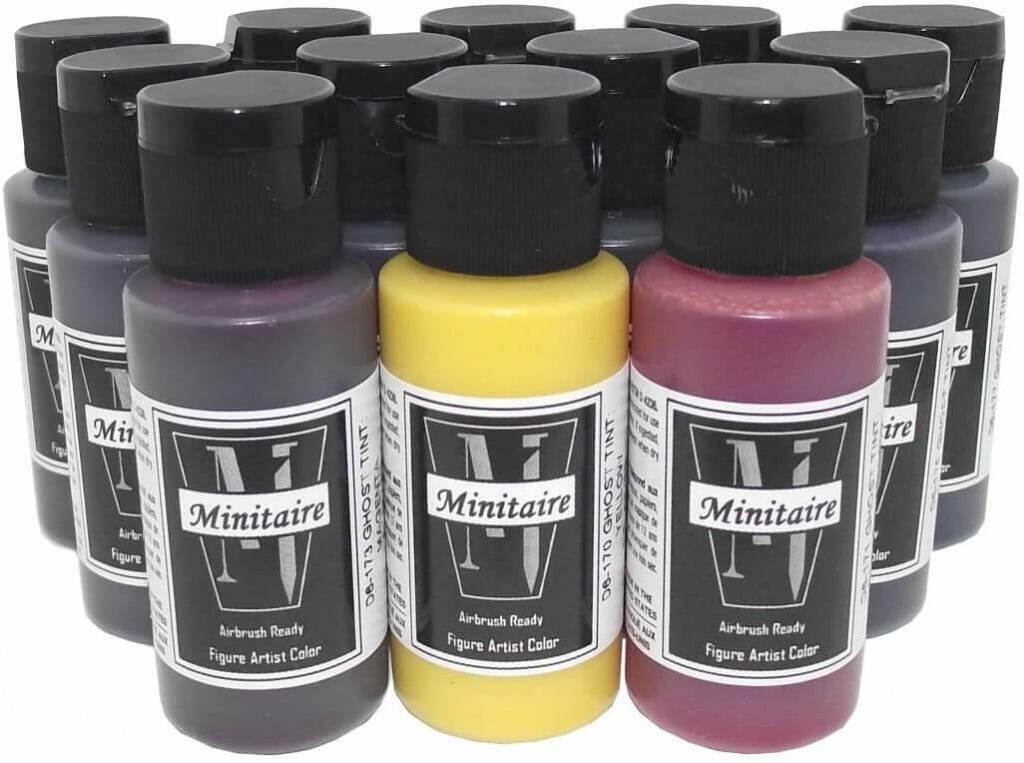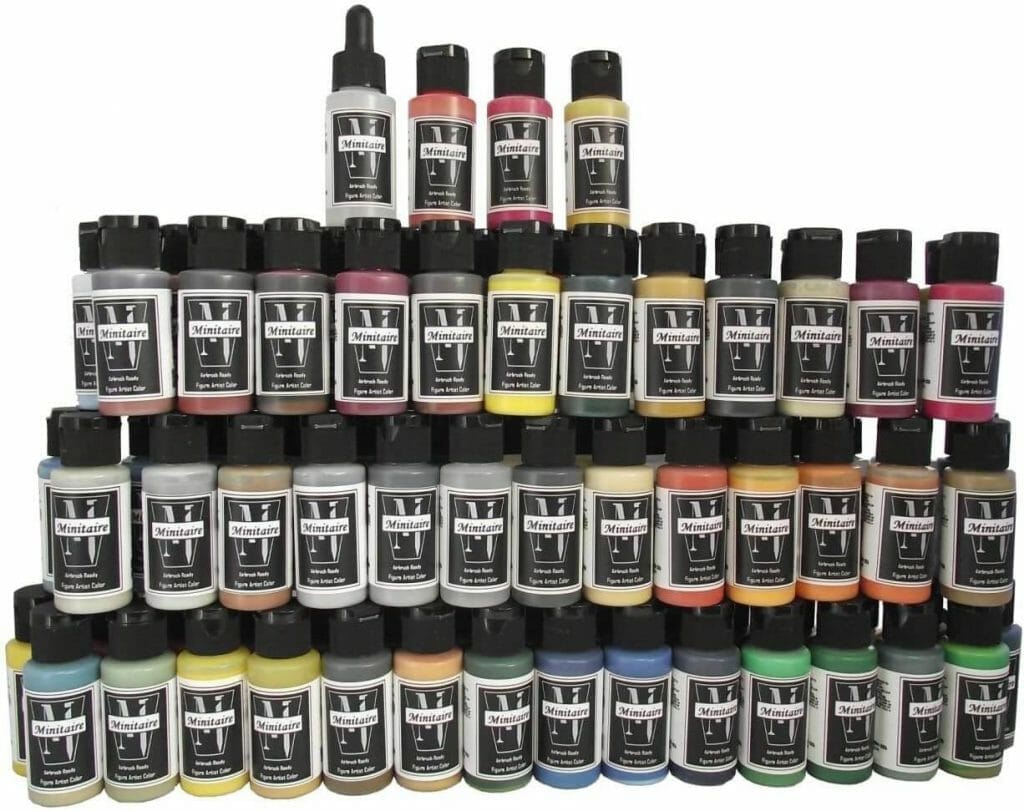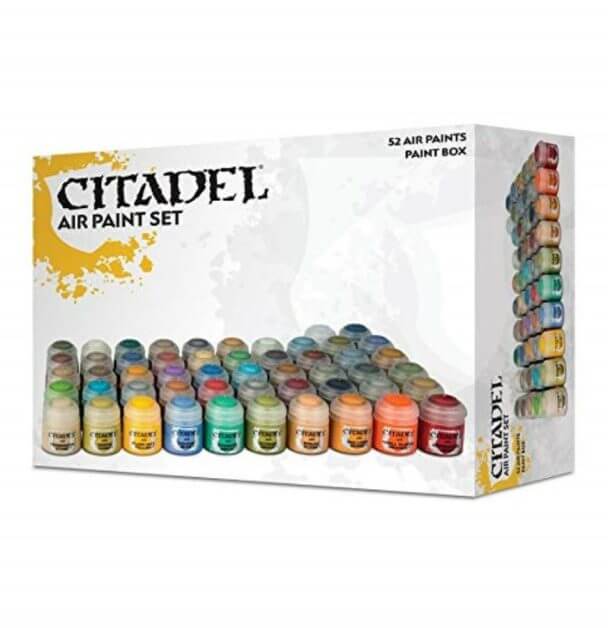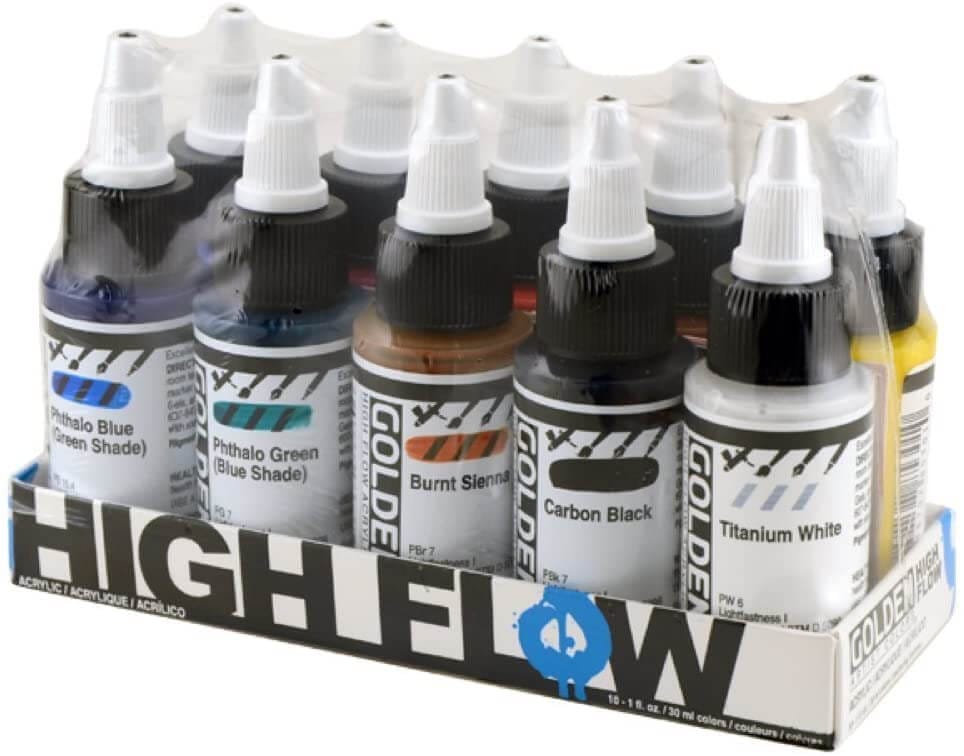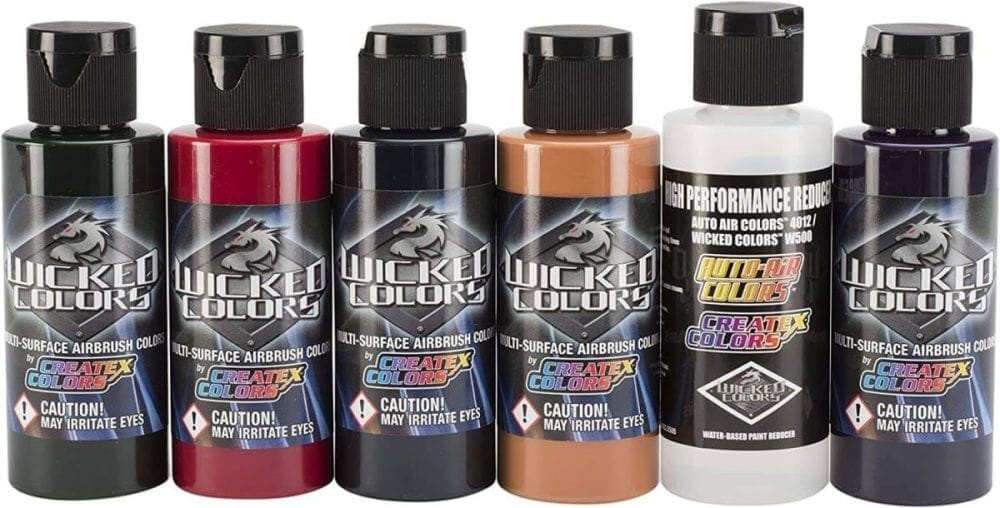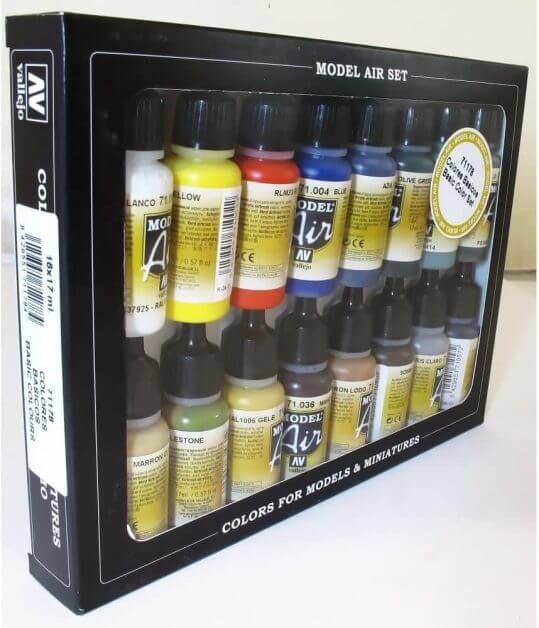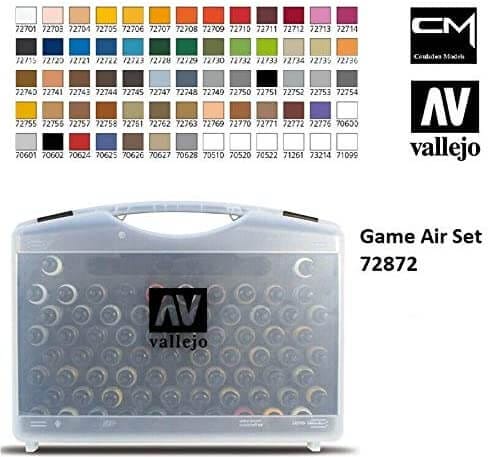Are you searching for the best miniature paints for airbrushing? Did you know you can use regular model acrylic paint in an airbrush? All you need to do is thin your normal miniature paints for it to flow properly through an airbrush. However, if you’re looking for premixed model paint formulated for use in your favorite airbrush, then you’re in luck! A number of companies make great airbrush-ready paints for miniature and model painting. These paints have generally have great coverage, color variety, and easy-of-use. Best of all, you don’t have to DIY your miniature paint mixes to get them to work with your airbrush. Whether you’re painting wargaming miniatures, e.g., Warhammer 40k, Age of Sigmar, or other gaming or scale models, then check out the great airbrush paints here.
In this article, I review some of the key things you want to know for using airbrush paint for models, and highlight a few features you may want to look for in the best paints for airbrushing. Along the way, I also show you some tips for easing yourself into the hobby of airbrushing miniatures.
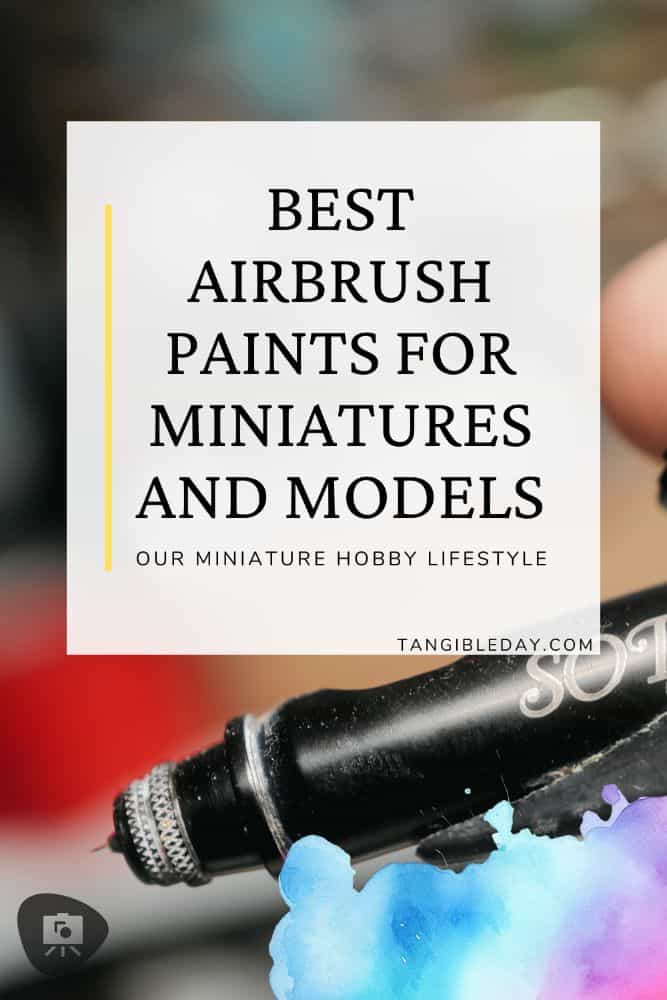
Here are the best 8 airbrush paints for miniatures and models:
Continue reading for more details about airbrush ready paints and the review of the top 8 airbrush paint for models! 🏆
What’s the difference between “airbrush-ready paint” and “regular model paint”?
Good question!
There are more similarities than differences between airbrush-ready paints and regular acrylic model paints. Both airbrush-ready paints and regular model paints use water-based acrylic polymer formulas as the foundation for the paint. In many cases, the color pigment saturation, durability, and overall final result on a miniature are also the same.
The main difference between airbrush ready paint and normal model paint is viscosity. In some brands, there are also additives in airbrush-ready paints that act as lubrication in the airbrush. This helps keep paint flowing nicely and prevents clogging. Finally, some airbrush ready paints have slower drying properties that prevent what dreaded needle “tip dry”.
If you’re asking what is better… well, of course, it depends on your use.
Remember: You can apply airbrush-ready paints with a bristle brush. And, if you’re comfortable with mixing thinner (usually just water) with regular acrylic paint, then you can use your airbrush with normal model paints. See more below!
RELATED: TOP 10 AIRBRUSHES FOR PAINTING MINIATURES
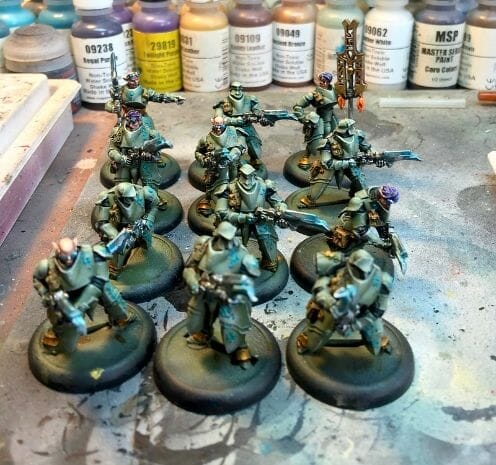
Can you use normal miniature paint with an airbrush?
Yes!
You can use any acrylic model paints with your airbrush. All you have to do is make sure you have the right viscosity (or thickness) of paint, which is fairly thin. Here’s a complete guide for airbrushing miniatures, including tips for how to thin your paints.
The best nozzle size for airbrushing regular model acrylic paint is 0.3mm or greater. With a nozzle that is smaller than 0.3mm, you are more prone to clogging your airbrush. On the other hands, with nozzle sizes that are too large, you lose a lot of spray detail control and resolution with your airbrush application.
The air pressure you should use for all airbrushing depends on 1) how thin your paint is and 2) the size of your airbrush nozzle and 3) the level of detail you are painting. In general, I use my Badger Patriot 105 airbrush with my Badger Aspire Pro compressor set at an air pressure of around 20-25 psi (i.e., pounds per square inch).
For a quick and easy way to adjust your air pressure for your airbrush, use the “skin dimple” test. At the proper PSI, your airbrush air flow should dimple the skin on the tip of your finger. Lower your airbrush pressure until it barely dimples the skin.
What is great about this approach is that once you get your air pressure correct, all you have to worry about is the thinness of your paint. Thin your paint for your needs!

READ MORE: PORTABLE PAINT AND HOBBY WORKSTATIONS FOR MINIATURES AND MODELS
What do you need an airbrush for?
Here are 5 quick reasons why an airbrush is useful for painting miniatures:
- Priming
- Base coating
- Glazing
- Stencils
- Varnishing (sealing your model)
1. Priming
It is much more cost-effective to airbrush your surface primer on a model than with a spray can primer. Here are some of my favorite primers. The best airbrush primers include Vallejo Surface Primer and AK Interactive Primer. Simply add your primer to your airbrush (thin if necessary with water) and quickly prime your models in preparation for paint.
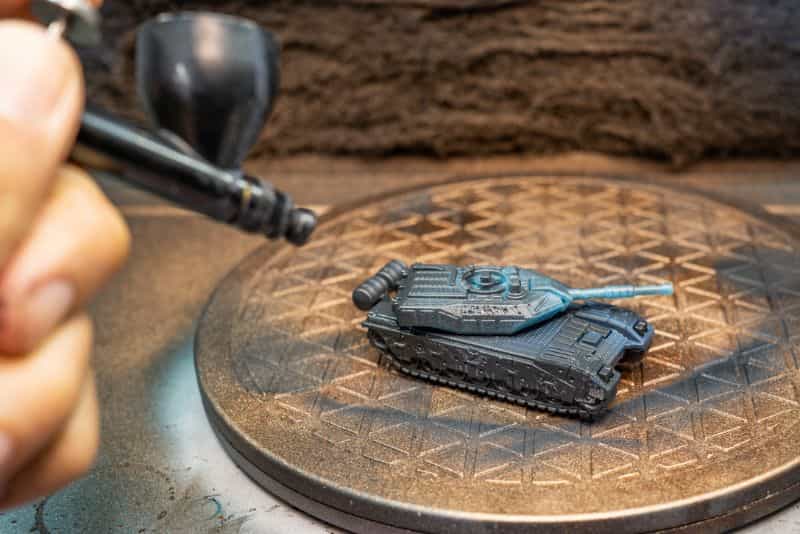
RELATED: AIRBRUSH OR BRUSH-ON REVIEW OF VALLEJO SURFACE PRIMER
2. Base Coating
Everyone who first buys an airbrush starts practicing with base coats. There is good reason for this. Base coating doesn’t require fine spray control and with an airbrush base coating is fast.

Also, because air brushes for painting tend to lay down color over a large area efficiently, you can preserve all the details of your miniature’s surface and work quickly.
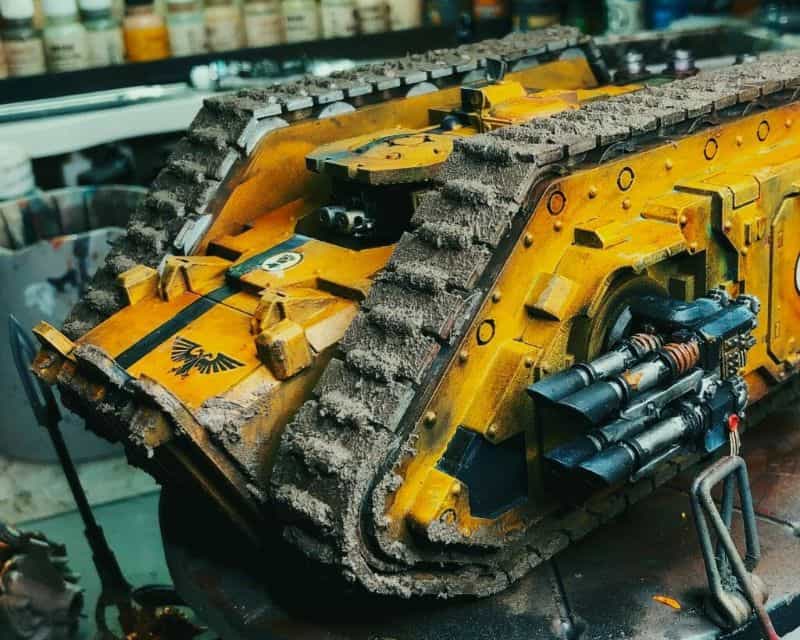
Nothing beats a quick, even base coat when you want to get something done. If you’re painting a large batch of models the same color, airbrushing the base coat will save you a ton of time!
3. Glazing
Glazing is simply applying a thin, translucent layer of paint over another color. The overlying glaze will shift the color tone and is very useful for creating subtle color blends and smooth transitions.
An airbrush is the ideal glazing tool for large open surfaces because you can apply very light coats of thinned paint evenly. If you’re familiar with zenithal highlighting, an airbrush is a great way to apply color over your black and white undercoat. Also known as slapchop painting, this process also works to speed up your painting process.

You can certainly airbrush acrylic inks for glazing as well. Because of acrylic ink color depth, saturation, and ease of use with an airbrush, I also use these media for glazing.

4. Stencils
If you’re looking for the most unique looks on miniatures (other than freehanding), you can try using airbrush stencils. You can even make your own stencils for airbrushing. With an airbrush and a good set of stencils there are a lot of great special effects you can create that will set your miniatures apart.
More than that, using stencils are fun and simple to learn how to use with an airbrush. If you want to try them out, check our some of the best stencils for airbrushing models.
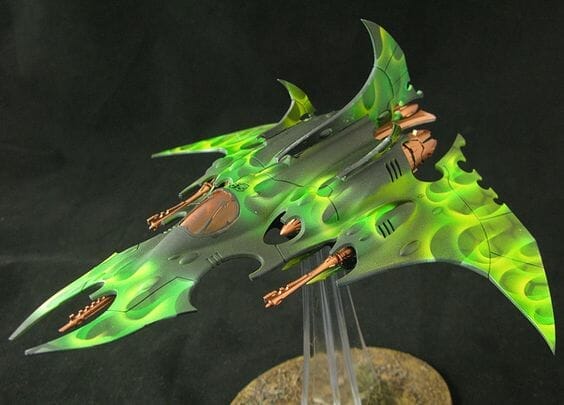
5. Varnishing (sealing your model)
Okay, you’re done painting. Now what?
Well, you need to protect your painted miniature from damage, scuffs, and other insults that may occur while handling. You can use a spray can primer like Testors Dullcote (more use and recommended details here), or use your airbrush to apply a varnish.
Water-based varnishes tend to be less durable than enamel lacquer varnishes, but are less toxic and you can apply them easily with your airbrush (or regular brush).
| Liquitex Matte Varnish |
|---|
 |
| Buy on Amazon Buy on BLICK ART |
Avoid doing this with any airbrush
Don’t let any acrylic paint dry in your airbrush. It doesn’t matter if it is an airbrush-ready paint or regular paint thinned out with water. When acrylic mediums dry in your airbrush, you’ll end up with a long road for cleaning it all out. Acrylic polymer dries into a hardened surface.
If you do end up forgetting (or neglecting) to wash out any leftover acrylic paint in your airbrush and it dries, here’s what you can try and do:
- Soak your airbrush in Winsor & Newton Brush restorer – this works wonders on badly clogged or dirty airbrushes. Make sure you wash out the restorer before you start airbrushing again.
- Use an ultrasonic cleaner – an ultrasonic cleaner uses high frequency sound waves to break up stubborn debris, paint, and other foreign material from your airbrush without damaging any of the fragile parts. To avoid damaging the tip of your airbrush needle, remove it from the airbrush and put it aside. In other words, don’t use the ultrasonic cleaner on your airbrush needle.
How to thin regular miniature paint for airbrush use?
It’s really easy to use regular miniature paint in your airbrush. In fact, once you get the hang of what to do, you may never need to use airbrush-ready paints!
RELATED: QUICK GUIDE TO AIRBRUSHING MINIATURES
Remember that some acrylic model paints are more viscous than others and may require more thinning. Also, some paints are easier to thin with better results than others. I find that brighter colors, e.g., yellows, whites, are harder to thin properly than darker or desaturated colors. But, in general, this shouldn’t matter, and with a bit of experimentation you’ll find that any acrylic paints can be used with your airbrush.
The best regular model paints for airbrushing in my experience include Reaper Master Series paints and Scale Color paints. They thin well with water and still provide sufficient binding properties when sprayed on a model’s surface with an airbrush.
What should I thin my normal paints with for airbrushing?
In general, I recommend using water for thinning any acrylic water-based paint for airbrushing miniatures and model. Water is “free”, abundant, non-toxic, and harmless for the airbrush. The downside of using water, of course, is that if you use too much water the acrylic paint may lose it’s “sticky” properties and slide too easily off your model.
Acrylic paints have an acrylic polymer binder that helps it adhere to your model’s surface. If you add too much water, you dilute this binder beyond what it is capable of doing and your paint will become “runny”, “splatter”, or bead up on your model.
If you want to avoid the hassle of figuring out the proper ratio of water to avoid losing the binding properties of your paint you can use a premade airbrush thinners. In this case, I highly recommend Vallejo Airbrush Thinner. This additive will help thin and lubricate your regular acrylic paints, e.g., Citadel, Vallejo, Scalecolor, and help it flow through your airbrush without clogging, splattering, or other annoying issues.

To thin an acrylic paint, here’s what you do:
- Mix your paint with a thinner. Place a few drops of your acrylic model paint in your palette well. This could also be a bottle cap or other small container. Then, add a drop(s) of water or thinner. Mix the paint and water thoroughly.
- Check for the proper consistency and viscosity. To do this, dab the back end of a paint brush handle into the mixture. Lift the handle out of the mixture. At the correct thinness, the paint mixture should drip easily off the handle. For example, at proper airbrushing viscosity, within 1-2 seconds of lifting the handle out of the mixture, a droplet should form and fall back down into your palette. If it drips too quickly (>1 second), then your paint mixture is too thin (though you could still use it; the coverage will be slow and require multiple airbrushed layers). If the drop doesn’t slide off the back end of your paint brush handle within 2 seconds, your paint is still too thick. Continue to add thinner to thin your paint further.
If you go through these steps, eventually you’ll end of what a paint-water (thinner) mixture that has a consistency of “milk”. At this viscosity, your acrylic paint should spray consistently and reliably through an airbrush with a 0.3mm nozzle at 20-25PSI.
To transfer your paint mixture to your airbrush paint cup, you can use an eye dropper or plastic pipette. These are easy to wash out and reuse. I don’t recommend performing the mixing in your airbrush paint cup directly because this can often lead to clogging (as thicker, unmixed paint will sink deeper into the recesses of the airbrush). Try and thin your normal acrylic model paint outside the airbrush before using it in a spray application.
When in doubt, it is better to have paint that is too thin than too thick. Paint that is too thick will clog your airbrush nozzle and is a hassle to clean out. Paint that is too thin will splatter, but you can lower your air pressure or spray further back from your model to remedy this problem.
What to look for in an “airbrush-ready” model paint?
- Coverage
- Viscosity
- Durability
- Color variety
- Bottle ergonomics
- Price
Not all airbrush-ready paints are created the same. Here are few things you should look for when deciding what airbrush-ready model paint to use. The best airbrush paint for models will depend on what you’re planning to do.
Coverage
This determines how well does the paint cover a model in a single coat. Similar to any acrylic paint, some airbrush ready paints have better color coverage than others. If you’re looking to use your airbrush to base coat models, then you’ll want an airbrush ready paint that has good coverage. This also means that the paint you choose will likely be thicker or have higher color intensity.
For my use, I prefer airbrush-ready paints that have great coverage. If I need a more translucent paint for glazing, for example, all I need to do is thin the paint a bit with water.
Viscosity
Some airbrush ready paints have a thicker consistency than other paints. It depends on the brand and the purpose of the paint. For example, Badger Ghost Tints, which are designed as a translucent glazing “ink” are very thin and watery. You’ll want to airbrush this at lower air pressures.
On the other hand, Vallejo Model Air paints have a thicker paint consistency and have great coverage as a result. But, Vallejo Model Air paints are not easily thinned to translucency without using an additive like the Vallejo Airbrush thinner. Thinning Vallejo paint with water tends to break up the acrylic polymer a bit too much for my taste.
For some airbrush styles, such as if you’re using airbrush colors to glaze your miniatures (as a way to blend paint), a thinner viscosity modeling paint may be better.
You can use a model paint mixer to help you mix thinner and paint for your airbrush.
Durability
This is related to the ability of the paint to avoid peeling, cracking, or scraping off the surface of a model. In general, I have not found any difference in airbrush-ready paints and regular model paints. I also haven’t noticed a difference across brands of airbrush-ready paints in terms of durability.
Note that airbrushed layers of paint are usually very thin, and by nature will be more fragile than thicker coats applied by regular brush. Be gentle when handling airbrush painted surfaces because of this reason. And, always finish a paint job with a proper varnish application.
Color variety
Many airbrush ready paints come in sets of various sizes. Depending on how much you want to spend, you can buy an entire line of airbrush colors or simply purchase your paint color a la carte. Yet, not all brands of airbrush ready paints have a wide variety of colors. So if you’re a collector or completionist, be aware that it’ll be harder to acquire the entire line of Vallejo paints than it is for Citadel Air paint (which are fairly restricted in number).
If you’re planning to use non-hobby, pro artist grade airbrushable paints, then your options for deciding what colors are available to you increase to ad nauseum.
Remember, airbrush art comes in all genres and needs, e.g., nail salons, wall murals, custom aibrushing for T-shirts. It is incredible how many art brands and colors become useful for miniatures when you don’t limit yourself to hobby brands. Just remember to consider coverage, durability, and viscosity as important factors when shopping pro artist grade paints for airbrushing miniatures.
Bottle ergonomics
The ability of a paint bottle to help you dispense paint is often overlooked. But, ergonomics matter a lot! Some airbrush paint bottles are pots with flip caps, i.e., Citadel Air paint, whereas other use dropper style tops, i.e., Vallejo.
The hassle of trying to transfer paint from a flip cap pot to a palette or to your airbrush paint cup is not something to ignore. In my estimation, the best designed paint bottle for airbrushing is the Vallejo style dropper. If you decide to collect a large number of Citadel Air paints, I suggest transferring the paints to dropper bottles (see how here).
Badger minitaire airbrush ready paints use a flip cap/dropper hybrid that works but is prone to unwanted drips and spillage. It works, but isn’t as useful as the Vallejo dropper bottle style.
Price
With airbrush-ready paints, be aware that you’re technically getting less paint per cost than a normal acrylic paint of similar volume. This is because airbrush-ready paints are pre-thinned. In terms of cost-benefit, the best value airbrush-ready paints is Badger Minitaire paint line followed closely by Vallejo’s Model Air or Game Air line of airbrush-ready paints.
Continue reading for details about what airbrush paints best fit the bill model and miniature painting.
Top 8 Best Airbrush Paints for Miniatures and Models
Here are my 8 recommended best airbrush paints for painting miniatures and models:
Golden Transparent Highflow Acrylics are one of the most versatile airbrushable paints available. They are not branded as hobby paints or anything, but I have discovered that they flexible in terms of what you can use them for.
You can apply them with your airbrush or a regular brush. They come in fairly large volumes (~28ml or 1 ounce) with a twist cap dropper style bottle. Some of the colors are transparent, which is great for glazing. This is particularly useful for airbrushing color over a zenithal highlighted model. The opaque colors work great for basing terrain pieces or large vehicles.
In general the colors in Golden High Flow paints are intense that have great flow characteristics for airbrushing. If there is a warning with these paints is that they tend to dry very fast. You can avoid clogging by adding a little airbrush thinner or acrylic drying retarder. Only use a small amount of these additives. A little goes a long way!
These Golden Highflow paints do create a glossy finish. You’ll want to varnish with a matte sealant when you’re done to keep unwanted reflections off your models. Overall, these are a great set of airbrush-able paints that I found have a lot of utility in painting miniatures and models.
Wicked colors are great for airbrushing different surface types. This includes plastic, resin, or metal miniatures and models. In my experience, this or Badger Minitaire are probably the best airbrush paint for 3D prints. Though, you will still want to start with a good primer. I’ve used wicked colors to airbrush wood, cardboard wargaming terrain, and other odd materials you may use scratch building scale models.
You can buy Wicked colors in most art stores in single paint colors or in sets. The colors are generally transparent, which I like using over a black and white undercoat.

Out of the bottle, Wicked colors are airbrush ready and provide excellent coverage. The paint is also easy to thin and resilient to “over-reducing” effects that may disrupt the integrity of other acrylic polymer paints. The color is thin enough to airbrush well at low air pressure without losing control (e.g., atomization is excellent).
The pigment is light-fast (it won’t fade in harsh UV light) and will dry glossy. As with any of my models, I prefer a matte finish and will seal my completed projects with a matte varnish like Testors Dullcote.
Vallejo Model Air paints are amazing for painting miniatures. They are highly regarded by many miniature artists. Not only do they work great with an airbrush, you can use these paints with a regular brush without thinning.
Vallejo Model Air paints have a similar color palette to the Vallejo Model Color line of paints, which are designed for scale modelers. This means that most of the color in the model air paint line are more realistic, less cartoony than gaming model paints.
I personally prefer painting my models with a more realistic flair, and therefore love using these Model Air paints whenever I can.
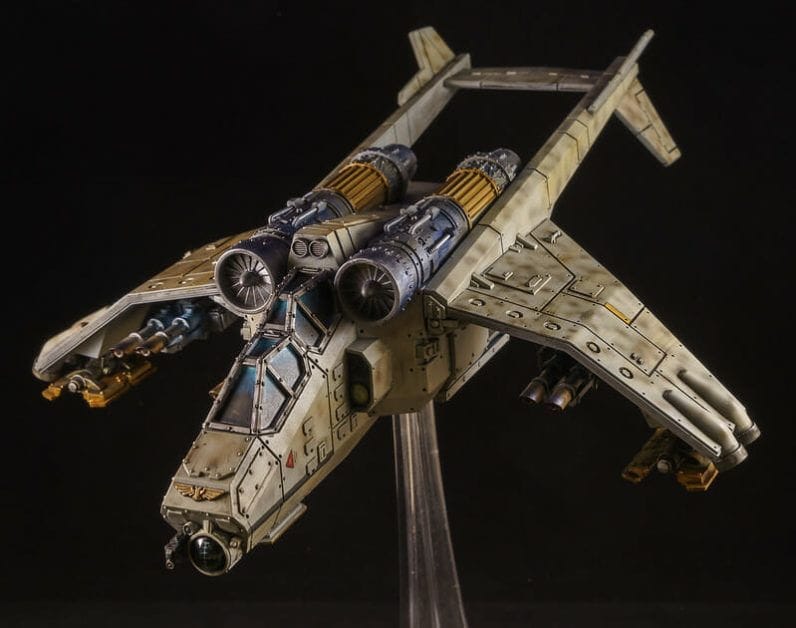
The paints flow nicely through an airbrush without much work. You may want to thin them a little to spray at lower air pressure for finer detail work. But, in general, with a 0.3mm nozzle and at 20 PSI or so, you’ll achieve fantastic atomization with these paints. They don’t dry too quickly and have a semi-matte finish.
If you’re unsure of what paints to get for airbrushing, you can’t go wrong with Vallejo Model Air color paints. This particular set is a great starter, which provides with the basic 16 core colors you’ll want for general miniature painting.
The Vallejo Model Air Paint Case Set is one of the most self-controversial purchases I’ve made. As much as I love the Vallejo Model Air paint line for airbrushing models, when I purchased this HUGE set I realized later that I didn’t need all the colors. I could have saved some money by only buying the colors I needed or wanted.
(Okay, I also realized that this recommendation is redundant with the previous. But, I wanted to list it because it’s a great value if you want to own the entire Vallejo Model Air paint line. Note that if you already have Vallejo Model Air colors, this case will have duplicates of what you already own).
As mentioned above, Vallejo Model Air colors are one of, if not the best airbrush-ready paints you can buy for painting miniatures.
There are 142 colors in the paint set and each one is unique (so no overlap). I will say that if you’re still in the early stages of buying paint and simply not sure what you’ll want later down the line, this set does save you some money as compared with buying each color separately. The case is pretty useful, too, if you tend to store your hobby things away or want some portability.
Vallejo Game Air Paints are the “airbrush-ready” equivalent of the Vallejo Game Color line of model paints. Vallejo Game Color paints are a close match to Citadel paint colors (you can download a paint color conversion chart here).
If you’re painting gaming miniatures, such as for Warhammer 40k or Age of Sigmar, or other wargaming tabletop models, this airbrush paint kit will give you the colors for some of the most popular studio paint schemes.
In my experience with other Vallejo products, including Game Air, you’ll find these paints to have great coverage, predictable and consistent application with your airbrush, and excellent durability. The dropper bottles are convenient (and the same as the Model Air paints), which help you dispense the right amount of paint directly into your airbrush paint cup. No thinning necessary.

I do find these paints to have a more glossy finish than the Model Air line. But, you can always tone down the reflections with a matte varnish or sealant. I’ve also found that the pigments in Vallejo Game Color and Game Air paints tend to separate fairly quickly and badly if they sit around for a while.
For best results, make sure you mix/shake your paint bottles well before use. I recommend using a small motorized paint shaker or mixer if you have a lot of paints or want to save time.
Badger Ghost Tints should be your first (or close second) airbrush paint set buy! Why? Well, they are unique but so useful that you’ll be reaching for these whenever you need that extra oomph for your models.
Ghost Tints are super thin, highly transparent inks that work almost like a color intense dye for your miniatures. They are designed for airbrush use and require no thinning. Though you can apply them with a regular brush, they work best with an airbrush in my experience.

They colors are very strong, so if you prefer, you can thin them easily with water for a more subtle color coat.
The transparency of all the colors makes adding a bit of color pop or flair, or accent so easy with an airbrush. Using low air pressure, you can add subtle color to skin tones, weathering effects on vehicles, burnt carbon on weapon barrels, or quickly create object source lighting (OSL) effects on models.
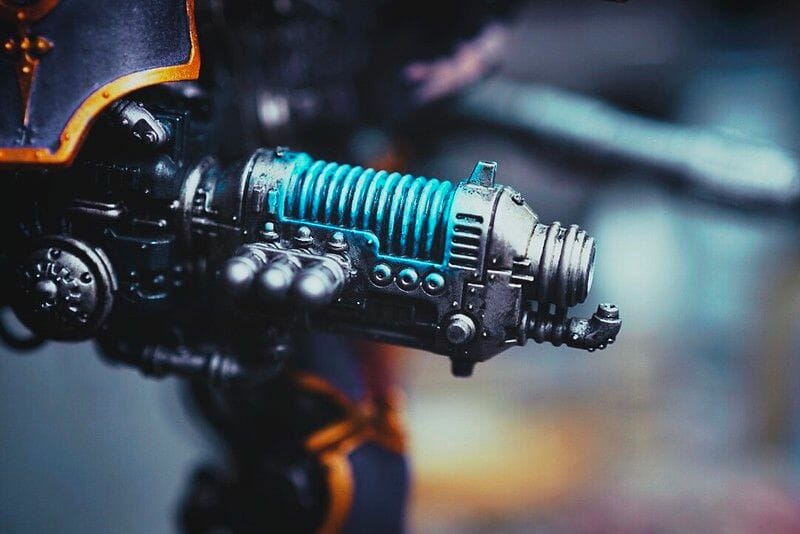
My favorite colors in the Ghost Tint set is Plasma Fluid, Fresh Blood, and Oil Discharge. These colors easily create amazing glowing effects, bloody organic spills, and a mechanical wear n’ tear look that is hard to replicate with other art mediums.
I highly-recommend you try out Badger Ghost Tints with your airbrush!
Badger Minitaire Colors are a line of airbrush-ready paints that come in a large variety of colors. This minitaire paint set comes with 80 colors, which comes out to just over $2 per bottle. The colors are fairly unique as compared with other major hobby brand paints.
I bought this entire set a few years ago and have only recently emptied a bottle or two. You likely won’t need all the colors in the paint set, but it is nice to have options!
The paint have good coverage, but are a little harder to work with than Vallejo’s brand of airbrush ready paints (e.g., Model Air or Game Air). Depending on the color, minitaire paints may be too thick to use directly from the bottle. You will have to play around with thinning them to get the paints to work well with your airbrush (which kind of defeats the purpose of an “airbrush ready” paint). But for the price, I still think it’s one of the best value airbrush paints you can buy for painting miniatures.
The paints are very durable on gaming miniatures, and work great as airbrush paint for model cars, e.g., RC shells. Whereas other airbrushed model paints may peel or scratch off if not properly varnished, I found Badger minitaire paints hold up well even on my most handled painted board game miniatures, e.g., Zombicide, Mansions of Madness.
The pigments in these paints also tend to separate pretty fast and significantly. You will have to shake the bottle each time to get the best results from using the paint.
Games Workshop Citadel Air Paints are an enigma. The set comes with 78 paints (though you can buy each color, separately), which matches many of the normal Citadel Colour range. The Citadel Air paints, of course, are thinned with a formulation that make them ready for your airbrush. Each Citadel Air pot holds 24 ml of paint, which is twice more than the regular sized pots at 12ml.
I’ve only tried a few colors, including the yellows, which are notoriously hard to get good coverage with using normal model paints. They work well and do the job. Except, I find the design choice of using the flip cap pots for these airbrush paints odd given the difficulty of transferring the paint to your airbrush.
You waste a bit of paint getting the color into your airbrush paint cup. It doesn’t matter whether you using a brush, pipette, or pouring it from the pot to your airbrush paint cup, some will be lost.
The cost of Citadel Air paints on par with most of the regular Citadel layer and base paint line. But realize that you’ll likely use up the Citadel Air paint much quicker because it is thinner and you’ll be losing some in the transfer process to your airbrush.
Remember, you could always use your regular acrylic Citadel layer/base paints with your airbrush by thinning them properly (see above).
On a different note, the advantage of these paints is that they merge and match up well with the other Citadel paints you may already be using. And, this advantage should be underscored as it is a HUGE benefit if you’ve already painted a portion of your model collection in a particular color want simply want to start using your airbrush to speed things along.
Finally, Citadel Air paints hold up well like normal gaming model paints. The paint layers are durable (though you’ll still want to varnish your completed painted miniatures). The paint also has great coverage, color intensity (matching regular Citadel paints), and work really well in an airbrush, e.g., you don’t need to thin them at all. In fact, it is no surprise that they work as well in an airbrush like Citadel Contrast colors, which have a nice unique transparency to them, too, when airbrushed on a miniature.
If you’re looking for a faster, simpler way to airbrush Citadel colors on your models, then Citadel Air paints may be the right choice for your project.
Conclusion
I enjoy airbrushing miniatures for the unique look and effect that you can do. When you get really good with using an airbrush, you’ll find that you can perform a lot of different color blending and smoothing techniques that may be hard to do with a regular brush.
Although you can mix and thin regular acrylic paints for airbrushing, it can take a bit of work and experimentation. If your mixture ratio is too thin or thick, you risk splattering paint on your model or clogging your airbrush. Both are annoying time sucks in a hobby that already has enough challenges.
If you’re looking for a simple and quick way to get going with your airbrush, then airbrush-ready paints may be your ticket. I’m certain I missed a few favorite brands and formulations, but I’m certainly open to trying out new paints when I can get a hold of them.
I hope you enjoyed this article and found it useful. If you have any comments or feedback for this article, I’d love to hear from you! Comment below 😃
Happy airbrushing and painting!



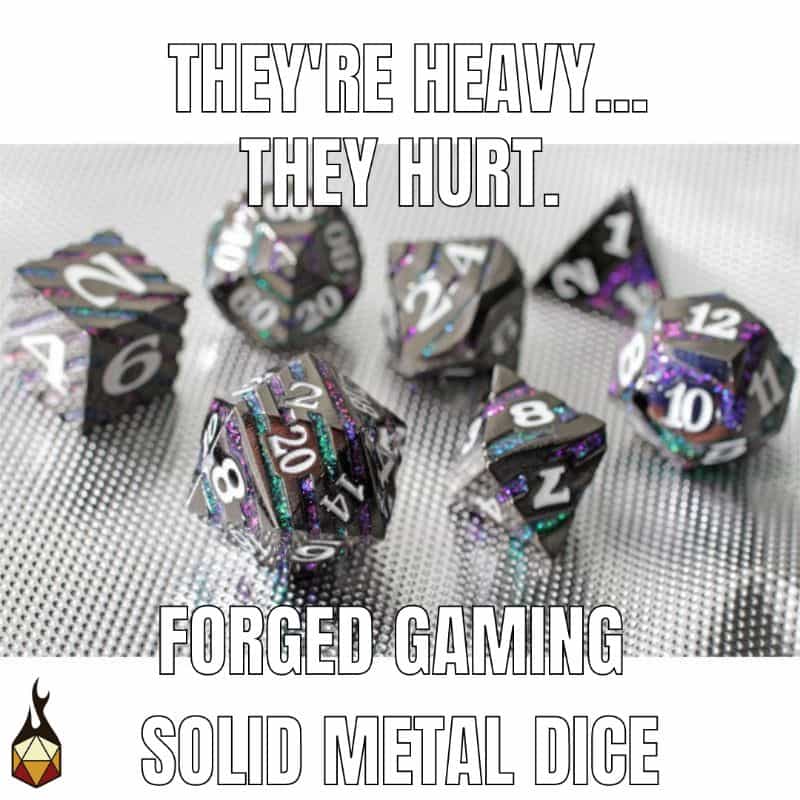


Tangible Day on YouTube (Miniatures and More!)

